Looking For The hair transplant in Navi Mumbai?
Hair Transplant is a process that involves the removal of hair from any site in the body and planting them on the losing area. PVR Aesthetica provides the best hair transplant in Navi Mumbai.
- No Recurrence
- Quick Recovery
- No Visible Scars
Book An Appointment Now!
Ratings
Trusted By Patients All Over India






Before & After
Hair Transplant






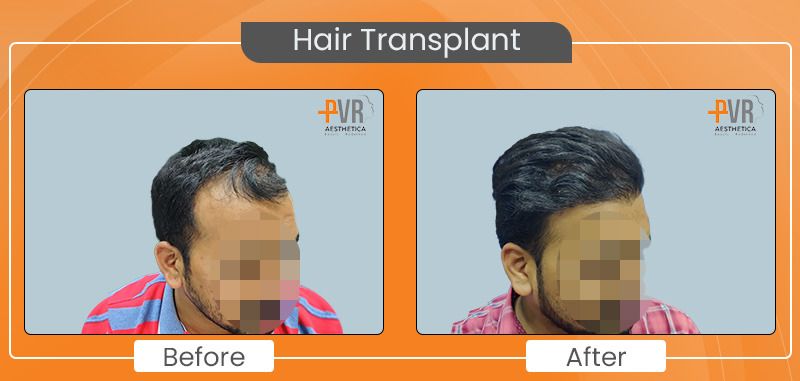




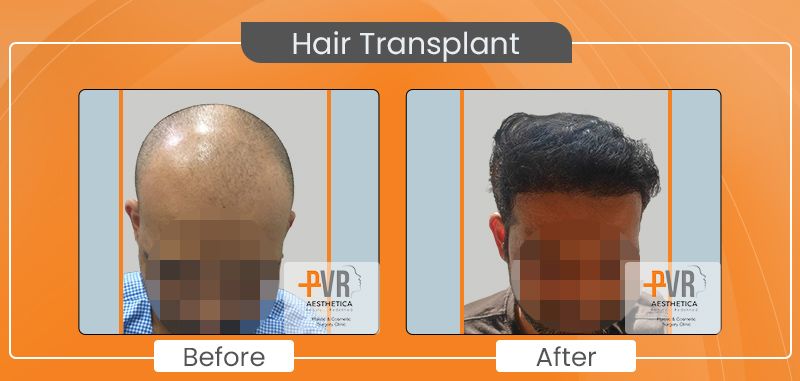

Facilities
At PVR Aesthetica we offer

Medical Expertise
Internationally acclaimed in medical care using modern technologies.

Excellent Service
Providing High-quality medical care and service at an affordable price.

Clinical Perfection
Our team works tirelessly to provide care and treatment of the highest standard.

Post-treatment Care
Quick recovery with adherence to post-procedure processes and follow-up consultations.

Why Us?
Why PVR Aesthetica?
PVR Aesthetica offers the most technically advanced medical care and cosmetic solutions. If you wish to seek a hair transplant by India’s most reputed cosmetic surgeon, walk into PVR Aesthetica for trusted hair care.
Our Team
Meet Our Doctor

DR. VINOD PACHADE
( MBBS, MS, M.CH, DNB, FACS, MNAMS )
Dr. Vinod Pachade is the founder and director of the PVR Aesthetica Cosmetic Surgery Center. He is the member of Association of Plastic Surgeons of India (APSI) and also the winner of Asia Book of Records.
He is a renowned plastic/cosmetic surgeon in Navi Mumbai. He specialises in :
- hair transplant
- Gynecomastia
- Breast surgery
Ready To Regain Your Hair & Confidence?
Consult Now!
FAQ's
Frequently Asked Questions
The will to get denser hair and a better hairline is required in a candidate. During the initial consultations, the doctor would thoroughly discuss the outcomes of the surgery and all the factors and risks associated with hair transplantation.
There is no gender limitation or age bar when it comes to hair transplantation. Patients in the age of 70 are also getting successful transformations. Those in their early 30s can opt for the procedure without a second thought. Women with specific hair loss patterns can also be candidates for the surgery.
There should be enough healthy hair on the sides and back of the head for a successful hair transplant surgery, as these areas act as the donor site. Hence, it is better to consider hair transplants in the initial stages of hair loss.
Ideal candidates for hair transplantation surgery are:
- Anyone with a particular baldness pattern
- Those who have hair loss due to scarring, scalp injuries and cosmetic procedures.
- Those who want to have fuller eyebrows and moustaches
- Those who have undergone surgery before
Want the best hair transplant in Navi Mumbai? Visit us at PVR Aesthetica and get all the details about excellent surgeons, facilities and infrastructures, and affordable hair transplant costs in Navi Mumbai.
Usually, a person starts facing hair loss from the front of the hairline because the sides and back of your head are genetically immune to hair loss. They are hence the ideal option as a donor site. When transplanted, hair follicles extracted from this region continue to grow and serve the purpose.
Donor dominance is the phenomenon where the grafted hair successfully grows in the recipient area. These grafts can either be micro (follicular) grafts or mini (follicular groups). Oen micrograft has around 1-3 hair follicles, whereas follicular groups have 4-6 hair follicles. Punch grafts have 20 hair follicles in each graft.
Do you want more information about the hair transplant cost in Navi Mumbai? Then, contact PVR Aesthetica and book an appointment for a thorough consultation. Our clinic has a well-experienced team of doctors like Dr Vinod Pachade, whose expertise in the field has made us one of the known hospitals for the best hair transplants in Navi Mumbai.
In the surgery, a small strip of hair containing the scalp is removed from the back or sides of the head. The region is carefully closed with stitches. There is a thin line scar left on the donor site, but the growing hair camouflages it.
The doctor and his team then work on the extracted strip of hair-bearing scalp. They can be processed in several ways as per the requirement of the case. The newly transplanted hair gives a very natural look. Follicular groupings are inserted for a denser and voluminous look.
The surgery is performed under anaesthesia (local or general). After the surgery, the doctor would check in follow up meetings to see if the hair is growing in the desired direction and pattern to give a natural hairline look.
The treatment is planned in the course of multiple sittings at decided intervals. Some patients achieve their desired look in a few sessions only. For micrografting and hair transplantation, one or two sittings are required at most which are placed several months apart to heal the scalp properly. Each sitting is of around 3-4 hours duration.
After the surgery, it is necessary to follow the guidelines and instructions of the doctor. You can get back to work and normal daily life activities 24-48 hours after the surgery. After the surgery:
- Gently wash your hair the following day
- Avoid any strenuous, high-intensity physical activity for 5 to 7 days after the surgery.
- Consume the prescribed medication without fail as they are crucial to controlling any infection.
- Some scabs and crusting might be present on the scalp for seven to ten days. But make sure you don't touch or try to pick it up as it can damage the newly placed hair grafts.
- The recipient's scalp and the donor region would be numb for around a few weeks to months.
- Visit your doctor regularly for follow-ups to see the progress of the surgery and any signs of infection or risks.
If you experience any complications after the procedure, it would be best to visit the clinic for a check-up.
Micrografting technique is done with extreme precision, thus leaving no or minimal scarring. They also conserve other hair follicles if they are required for future transplantation. The volume and density of the new hair depend on the extent of hair loss, density of the donor's hair and the number of procedures performed.
The transplanted hair usually falls off in a month. It is a regular part of the healing stage. In around 3 to 4 months, new hair starts growing in the region, fulfilling the surgery's goal. There will be a considerable amount of hair in the bald or thinning area with a natural look in approximately six months. After that, it keeps on growing further. The rate of hair growth varies from person to person. The incision line becomes nearly invisible in the donor site after being surrounded by the growing hairs.
Any medical surgery has some risks and possible complications associated with it, but they are minimal and happen in rare cases. However, these complications have been minimised to a great extent with the advancement in technology and new-age techniques. It is possible for some amount of bleeding or infection to occur. Following your doctor's instructions would help in a better and faster recovery. You should avoid consuming aspirin, medications which lead to blood thinning, herbal supplements and some kinds of drugs. Moreover, it would be best to discuss your existing conditions in the initial consultation meeting with the doctor.
Reviews
Patient Testimonials
Hair Transplant: Comprehensive Guide
This comprehensive guide provides you with an in-depth understanding of hair transplant surgery including ,the different types of techniques available,he ideal candidates for the procedure. Also explaining what to expect before, during, and after the surgery,the potential risks and complications ,and most frequently asked questions.
Understanding Hair Loss And Baldness
Hair loss can be caused by various factors, including:
- Hormonal changes Stress Illness Childbirth Heredity Burns Injuries,X-rays Cosmetic procedures Vitamin deficiencies Medical conditions or a normal part of aging
- Alopecia areata is an autoimmune disorder where the body’s immune system attacks hair follicles, causing hair loss.
- Hair loss can occur on any part of the body, including the: Scalp Inside the nose Ears Eyelashes Eyebrows
- Identifying the underlying cause of hair loss is important in determining the appropriate treatment options, which can range from:
- Medication
- Lifestyle changes
- Surgical procedures such as hair transplantation.
How Does A Hair Transplant Work?
Hair transplant is a surgical procedure that involves moving hair to bald or thinning areas of the scalp.
This procedure is also known as hair restoration or hair replacement. It is usually recommended for people who have already tried other hair loss treatments and have not seen satisfactory results.
Hair Transplant Surgery Vs. Other Hair Restoration Methods
Hair restoration methods can be categorized into surgical and non-surgical options.
- Surgical procedures are invasive and require stitches, with a healing period of approximately 10-14 days.
- Non-surgical options are non-invasive and have no recovery period, with immediate results.
- Results from surgical procedures can be seen between 6-9 months after surgery.
- Non-surgical options include medications like Finasteride and Minoxidil, Platelet-rich plasma hair treatment, steroid injections, scalp micro pigmentation, and hair replacement systems.
- Surgical options include hair transplants and hairline lowering.
- Surgical restoration procedures fall under three categories: scalp flaps, surgical excision, and free auto-grafts of hairy scalp.
What Conditions Does Hair Restoration Surgery Treat?
Hair restoration surgery can help in treating permanent hair loss caused by various conditions. One of the conditions that hair implants may help with is alopecia areata, which is an autoimmune disease that attacks hair follicles.
Another condition that hair restoration surgery may help with is androgenic alopecia, or pattern baldness, which affects up to 50% of males and females and is characterized by progressive loss of terminal hair of the scalp any time after puberty.
Hair restoration surgery may also be helpful in treating hair loss due to thyroid diseases or hormonal imbalances. Hair loss caused by thyroid diseases may develop slowly with hypothyroidism and hyperthyroidism, and hair may seem thinner all over instead of bald patches.
Additionally, traumatic injuries or burns can also lead to hair loss, and hair restoration surgery can help in treating such cases.
What Is The Difference Between The Male And Female Pattern Of Hair Loss?
| Male Pattern Baldness | Female Pattern Baldness | |
| Characteristics | Receding hairline that leaves an M-shaped pattern | Lack of receding hairline, low chances of forehead widening |
| Affected areas | Hair strands in temples and middle of scalp | Only hair in the middle of scalp |
| Cause | Presence of androgens, necessary for development of male pattern hair loss | High androgen levels in some women, but most women have normal testosterone levels |
| Onset | Androgen levels increase during puberty, leading to the onset of the condition | Prevalence of hair loss increases after menopause, attributed to hormonal changes |
| Hormone effect | Dihydroxy testosterone, a metabolite of testosterone, causes hair loss development in androgen-sensitive areas | N/A |
Who Is a Good Candidate For a Hair Transplant?
A good candidate for a hair transplant should have:
- healthy hair growth at the back and sides of the head to serve as donor areas.
- Men who have been losing their hair due to male pattern baldness for more than five years or who have progressed to class 3 or above on the Norwood Scale are good candidates for hair transplant surgery.
- Candidates should have realistic expectations and to have been balding for many years, but whose pattern has stabilized.
- Men and women who have lost hair due to trauma or burns or due to other cosmetic procedures such as facelifts may also be eligible for hair transplant surgery.
Other factors that affect the cosmetic result include hair color, texture, and waviness.
Age And Hair Transplant Surgery
Hair transplant surgery can be performed on individuals ranging from 21 to 80 years of age. However, surgeons generally prefer patients around 30 years of age.
This is because at an early stage of hair loss, it can be challenging to predict how it will progress. As a person ages, there may be additional hair loss, which can affect the results of the transplant.
Therefore, it is essential for individuals to discuss their candidacy with a qualified hair transplant surgeon and make an informed decision based on their individual circumstances
MCI Guidelines For Hair Transplant
MCI guidelines for hair transplant are as follows:
- Trained and licensed Registered Medical Practitioner (RMP) should only perform the hair transplant surgery .
- RMP must have adequate education, training, and current competency in the field of hair restoration surgery.
- RMP must have adequate knowledge in hair physiology, the pathogenesis of scarring and non-scarring alopecia, anatomy, and physiology of the scalp including scalp vasculature and nerve supply.
- RMP must possess adequate clinical skills to identify candidates for hair transplant surgery and recognize contraindications for hair transplant.
Essential aspects of hair transplant surgery that must be considered by the RMP:
- Preoperative diagnostic evaluation
- surgery planning and execution
- donor hair harvesting
- hairline design
- recipient site creation
- postoperative management of patient’s medical issues and possible adverse reactions
What Happens During a Hair Transplant?


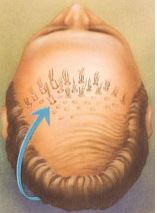
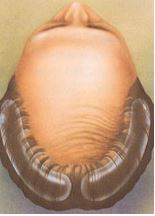
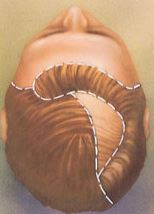
Hair transplantation is a surgical procedure that involves removing small punch grafts from the hair-bearing scalp in the donor area, which is then cut into smaller pieces to use as grafts.
These grafts are then relocated to a bald or thinning area of the scalp. The size and shape of the grafts vary depending on the number of hairs they contain.
Step 1: The surgeon uses a tube-like instrument to punch round grafts from the donor site.
Step 2: The grafts are then prepared and separated into the appropriate sizes.
Step 3: The surgeon creates tiny incisions in the bald or thinning area where the grafts will be placed.
Step 4: The grafts are carefully placed into the incisions using forceps.
Step 5: The incisions are then closed with sutures.
Alternatively, flap surgery may be used in which a section of bald scalp is cut out and a flap of hair-bearing skin is sewn into its place.
Another technique is scalp reduction, in which bald areas of the scalp are surgically removed and the hair-bearing scalp is pulled together and sewn. The exact technique used will depend on the individual’s unique situation and the surgeon’s expertise.
The procedure is typically performed under local anesthesia with mild sedation, and patients can usually return to work within a few days.
Types Of Procedures In Hair Transplant
Types Of Procedures In Hair Transplant are:
- FUT Technique Follicular unit transplantation (FUT, or strip method) process
- FUE Technique Follicular unit extraction (FUE) process
- Manual Punch FUE process
FUT
During FUT hair transplant technique, the procedure is performed as follows:
- The surgeon will mark the donor area on the back of the scalp.
- the head is not shaved only the area where the skin is removed is trimmed
- Local anesthesia is administered to numb the donor area.
- A strip of scalp skin is removed from the donor area using a scalpel.
- The donor area is then sutured or stapled to close the incision.
- The removed strip of the scalp is dissected into small grafts containing one to four hair follicles each.
- The surgeon will then create tiny incisions on the recipient area of the scalp.
- The grafts are carefully placed into the incisions in the recipient area of the scalp.
- Once all the grafts are placed, the scalp is cleaned and covered with gauze.
- After the procedure, the patient will have a linear scar on the donor area, which can be covered by hair.
- The patient can go home the same day and will need to follow post-operative care instructions provided by the surgeon.
FUE
During a Follicular Unit Extraction (FUE) hair transplant procedure:
- The back of the head is shaved to allow access to the donor area.
- The surgeon uses a small instrument like a needle or blade to create tiny holes in the scalp where the hair transplant will be placed.
- Individual hair grafts are carefully removed one by one from the donor area using a micro-punch tool or other specialized instruments.
- These grafts are then inserted into the tiny holes in the scalp that the surgeon has created.
- After the procedure, the scalp is covered with gauze or bandages that are removed after a few days.
- Stitches are usually not required with FUE, as the tiny holes created during the procedure will heal on their own.
- Full recovery may take several months, during which time the transplanted hairs will begin to grow naturally.
Multiple sessions may be necessary to achieve the desired level of hair growth. - Patients may be given a spray or other products to aid in recovery and hair growth.
Manual Punch Fue Process
Manual Punch FUE process was the original form of FUE before machines were developed.
In this technique, a punch loaded into a handle is rotated or oscillated back and forth between the thumb and forefinger while being pressed into the scalp, cutting around a follicular unit.
The punches used were modified biopsy punches that were quite large. For several years, manual FUE was the only form of FUE, but it is not as commonly seen today. Nonetheless, manual FUE is still being performed by many clinics.
Benefits Of Hair Transplant
Hair transplant surgery can provide numerous benefits to people experiencing hair loss. Here are the step-by-step benefits of hair transplant surgery:
Enhanced appearance: Hair loss can lead to loss of self-confidence and self-esteem. With hair transplant surgery, people can regain their hair and improve the way they look and feel.
Completely natural: Hair transplant surgery is a natural process that does not involve the use of any chemicals or medicines that can damage hair. It is completely safe and uses the patient’s hair to fill in the areas where hair loss has occurred.
No baldness: After the hair transplant surgery, there is a minimum chance of receding hairline and rare chances of baldness. The results of the surgery are effective and provide a long-lasting solution to hair loss.
One-time investment: Hair transplant surgery is a one-time process that eliminates the need for expensive special shampoos and chemicals. There is no need to visit the doctor repeatedly, and the transplanted hair is entirely like natural hair and needs no special care, attention, or maintenance.
Ultimate solution: Hair transplant surgery provides a permanent solution to hair loss, removing the need for a temporary hair loss solution. The results of the surgery last a lifetime, allowing people to enjoy the benefits of their new hair for many years to come.
Complications Associated With a Hair Transplant
A hair transplant is a surgical procedure that carries potential complications, which can be categorized as follows:
Anesthesia:
- Adverse systemic reactions to local anesthetics are classified as toxic, psychogenic, idiosyncratic, or allergic.
- Majority of reactions to local analgesics are psychogenic and related to fear.
Intraoperative complications:
- Tachycardia may occur when tumescent fluid containing adrenaline is administered.
- Patients with cardiac problems pose a risk.
- Patients above 40 years of age require an electrocardiogram and physician assessment for anesthesia fitness.
Postoperative complications:
- Syncope is a complication that can occur at the end of surgery due to various factors such as long surgery duration, pain, postural hypotension, Xylocaine toxicity, poor hydration, and hypoglycemia.
- To reduce the chances of syncope, hydration and electrolyte balance should be maintained during surgery, sudden changes in posture should be avoided, and clonidine should not be administered before surgery.
- Pain during and after surgery is a common complication
- Factors that contribute to pain include wide strip, bleeding, wound tension, and large sessions with inadequate anesthesia.
- Proper surgical technique and the use of analgesics can help manage pain.
- Field block using local anesthesia mixed with adrenaline can help reduce pain.
Contraindications
Some contraindications for hair transplant surgery are as follows:
Hair loss history:
- The presence of symptoms such as fever, pruritus, scaling, erythema, and rash, suggests an inflammatory condition, including frontal fibrosing alopecia and lichen planopilaris.
- Hair trauma caused by excessive brushing, scratching, and blow-drying can be a contradiction for hair transplant.
Medical history:
- Skin conditions such as vitiligo and pemphigus, thyroid disease, diabetes mellitus, metabolic syndrome, and autoimmune-related conditions, including lupus, sarcoidosis, and scleroderma, may affect hair growth and can be a contradiction for hair transplant.
- Systemic and local infections, including HIV, tuberculosis, syphilis, tinea capitis, and staphylococcal folliculitis, can also be a contradiction for hair transplant.
- Malnutrition caused by vitamin and mineral (iron) deficiency, recent childbirth, history of scar formation, and chemotherapy and/or radiation exposure can also be a contradiction for hair transplant.
Medications:
- Several medications such as propranolol, Coumadin, and amphetamines may affect hair growth and can be a contradiction for hair transplant.
- Antiplatelet and anti-coagulation medications should be stopped to mitigate bleeding risk.
Psychiatric history:
Stress, anxiety, eating disorders, trichotillomania, emotional trauma, and body dysmorphic disorder can be a contradiction for hair transplants.
Physical exam:
Hair loss that is localized, scarring, or inflammatory suggests a diagnosis other than androgenic alopecia, and a scalp biopsy may be needed to rule out an inflammatory or infectious cause of hair loss.
Women with a wide-spread pattern of hair loss throughout the scalp, people who don’t have enough “donor” hair sites from which to remove hair for transplant, and people who form keloid scars after injury or surgery may also be a contradiction for hair transplant.
Preparation
Preparations to do before undergoing a hair transplant:
- Avoid alcohol for three days before surgery.
- Don’t get a haircut before the surgery to allow enough hair growth for transplant.
- Depending on the extent of hair loss, medication such as Minoxidil may be required before the surgery.
- Antibiotics may be prescribed before surgery to minimize infection risk.
- Stop taking aspirin or anti-inflammatory medication at least two weeks before surgery.
- Beta-blockers, blood-thinning drugs, and antidepressants should be avoided for two weeks before surgery.
- Stop taking any multivitamin/mineral supplements or herbal supplements like Gingko Biloba two weeks before surgery.
What are the different types of hair transplant surgery?
Hair transplant surgery is available in several types, each with its unique features and benefits.
- Grafting – It is the most common hair transplant procedure is. During the procedure, the doctor removes tiny pieces of the healthy hair-containing scalp using a small, round punch, which is known as a hair plug.
Micro-grafts, containing one to two hairs, are also used. The procedure can take several hours, and the scalp is numbed, but people stay awake during the surgery. Multiple procedures may be needed, and the scalp will need to heal for a few months between them.
- Scalp reduction- also known as alopecia reduction. During the procedure, a small area of bald skin is removed from the scalp, and nearby skin containing hair is loosened and pulled over the bald area, then stitched in place. It is ideal for bald areas on the top and back of the head, and no general anesthesia is needed.
- Flap surgery – It is recommended if there are large bald areas near the front of your scalp. The procedure occurs in several phases over a few weeks, and superficial cuts are made around three sides of the donor site.
The fourth side remains attached, maintaining its original blood supply. This technique helps the surgeon cut the flap and lift it over bald areas. Flap surgery requires general anesthesia.
- Tissue expansion – It is done if there is scalp baldness or disfigurement due to burns. The procedure involves a reconstructive surgeon inserting an implant under the scalp, where the hair remains.
Shaped like a balloon, known as a tissue expander, the implant is gradually inflated over several weeks to stretch the skin. Then, a second procedure is performed to cover the bald area with the stretched skin. Tissue expansion requires general anesthesia.
Risks Of Hair Transplant Surgery
A hair transplant procedure can have both temporary and more serious side effects that you should be aware of:
1. Bleeding: During FUT or FUE, there may be bleeding and cuts, but doctors take precautions to keep them small. Bleeding may also occur during the recovery period.
2. Scars: Some permanent scars may remain on your scalp after a hair transplant, but healthy hair growth can cover them up.
3. Infection: Proper hygiene is important to avoid infection.
- Folliculitis, a bacterial infection that causes inflammation in hair follicles.
- Necrosis, a condition where scalp tissue becomes black and leathery, are possible complications that may require surgical intervention.
- Certain medical conditions, such as autoimmune conditions, HIV, high blood pressure, diabetes, and cancer, may increase the risk of wound infections.
4. Itching: Itching is a common side effect of a hair transplant, but you must resist scratching your scalp.
5. Swelling: Swelling around the eyes or forehead is common and can last for days or weeks after the procedure. However, it is usually temporary and will heal with time
Hair Transplants’ Side-Effects?
Here are some of the potential side effects to be aware of:
- A tight, achy, and swollen scalp for a few days after the procedure.
- Temporary scabbing where the hair was transplanted.
- A single scar or several very tiny scars, including hypertrophic scars and keloid scars, which are the result of an exaggerated healing response.
- Donor area wound dehiscence and necrosis, which are signs of delayed or nonhealing. Excessive tension over the suture line may also cause wound dehiscence due to necrosis of the skin margin.
- Neuralgia or hypoesthesia, which can occur when underlying nerves are insulted during strip harvesting or when electrocautery is used to coagulate vessels.
- Donor hair effluvium, is a rare occurrence that can happen due to accidental significant vascular damage, excessive suture line tension, smoking, and diabetes.
It is important to take care of your scalp and keep it hygienic to reduce the risk of infection. If you have any underlying conditions like autoimmune conditions, HIV, high blood pressure, diabetes, or cancer, you may be more susceptible to wound infections.
Other potential side effects to watch out for include itching and swelling, which are temporary but can be uncomfortable.
The Cost Of Hair Transplant Surgery In Navi Mumbai
The cost of hair transplant surgery in India ranges from INR 55,000 to INR 60,000 on average.
The total cost of the procedure varies depending on the number of grafts required, and whether or not surgery is necessary.
A 2,000-graft hair transplant could cost anywhere from INR 55,000 to INR 80,000. In contrast, a 5,000 graft hair transplant would typically cost INR 1,00,000 to INR 1,40,000 or more. Generally, the fewer grafts needed, the lower the overall cost
Factors That Affect The Cost Of Hair Transplant Surgery
The cost of a hair transplant surgery can vary depending on several factors, as listed below:
- Technique Used – FUE is typically more expensive than FUT due to the individual removal of follicles.
- Number of Grafts – The number of grafts implanted in the bald area determines the cost of the procedure.
- Stage of Baldness – The level of baldness influences the number of grafts required for the procedure and subsequently the cost of the hair transplant.
- Means of Extraction – The use of robotic technology to extract hair grafts increases the cost of hair transplants.
- Doctor’s Experience – A highly experienced hair transplant surgeon may charge more to perform the surgery.
- Donor Area Quality and Health – The quality and health of the donor area affect the number of grafts that can be extracted, and this can impact the cost.
- Number of Sessions – The patient’s scalp health and overall health influence the number of sessions required to complete the transplantation, and with multiple sessions, the cost of a hair transplant will go higher.
How Long Does a Hair Transplant Procedure Take?
The duration of a hair transplant procedure typically ranges from four to eight hours. In some cases, implanting 5000 hair grafts may require 7 to 8 hours and multiple sessions may be necessary.
For the FUT process, the duration can range from 4 to 12 hours, and up to 4,000 hair grafts can be transplanted in one session.
The FUE method may take more than one day in some instances. Patients are awake during the entire surgery and receive only local anesthesia that numbs the scalp.
The surgery starts by removing healthy hairs, which may involve either cutting a strip of skin with healthy hairs from the scalp or removing individual hairs to ensure natural-looking results.
The length of the procedure depends on several factors, including the technique used, the number of grafts implanted, and the patient’s health and scalp condition.
Post-Operative Care And Recovery
After having a hair transplant surgery, it is important to follow a proper postoperative care routine to ensure optimal healing and recovery. Here are some things to keep in mind:
Post-op care:
- On day 1, the bandages should be removed.
- On day 2, gently wash your hair.
- Days 3 to 5, you can return to work and engage in light activities.
- After 10 days, your healthcare provider can remove the stitches.
- After 3 weeks, you can return to exercise or sports.
Recovery:
- Most people can return to work about 3 days after the procedure.
- You should be very careful with your transplanted hair for the first 2 weeks as the grafts will not be secure.
- You may need to cut down on exercise in the first month to minimize scarring.
- After 2 to 5 days, any bandages can usually be removed, but you should not touch the grafts.
- On day 6, you should be able to wash your hair gently by hand.
- After 10 to 14 days, any non-dissolvable stitches can usually be removed.
- After a few weeks, the transplanted hair will often fall out but later start to grow back.
- After 6 months, new hair will usually start to appear.
- After 12 to 18 months, the full results of the transplant should be seen.
Managing Expectations
Managing a Hair Transplant Procedure:
- Expect that it can take up to nine months before the hair takes root and begins to fill in.
- Transplanted hair may fall out after several months and then regrow, which is normal.
- The hair should look natural since it is transplanted in the direction in which the hair would normally grow in that location.
- Most scars should be covered with hair and will be hard to see, and any visible scarring will be permanent but should fade with time.
- Improvements to scars may take a year or so, so patience is required.
- Shock shedding is a natural process resulting from the growth cycle of hair follicles, which includes transitional and resting phases.
- After hair transplantation, the hair follicles enter the resting phase due to surgical trauma and the self-protection process of the hair follicles, which is known as the shedding period.
- Shock loss is a common occurrence and nothing to worry about.
- After six months, hair growth is at its fastest, and hair strands start to get thicker and stronger each day, with coverage reaching up to 100%.
- Patients need to be patient and allow sufficient time for the proper healing of the transplanted hair.
Finding The Right Hair Transplant Surgeon In Navi Mumbai
When it comes to finding the right hair transplant surgeon, there are some factors to consider. Here are some tips to help you make an informed decision:
1. Ask for a minimum of 10 sets of before-and-after photos of previous patients to evaluate the surgeon’s work.
2. Request the names and phone numbers of at least six patients whom you can contact to discuss their experiences with the physician and staff.
3. Meet patients who have similar hair and skin characteristics to yours so you can see the results for yourself.
4. Ask specific questions for a FUT procedure, such as :
- whether the grafts are microscopically dissected if all technicians use stereo-microscopes.
- how long the technicians have been using microscopes.
- how many microscopes are used during a procedure.
- whether a single-bladed knife is used to excise the donor strip.
5. If you’re considering an FUE procedure:
- find out how many FUE procedures the physician has performed.
- who dissects the FUE grafts (the surgeon or technicians).
- the qualifications of the technicians if the surgery is technician-driven.
- whether the FUE grafts are examined and refined under a microscope before implantation, as this is critical to ensure a natural result.
FAQs
When Do Patients See Results From a Hair Transplant?
Results from a hair transplant are typically seen between six to twelve months after the surgery.
Although, for some patients, it may take up to 12 months. However, between two to eight weeks after the transplant, the transplanted hair will naturally fall out, which is a normal part of the process
Can Hair Transplant Surgery Fix a Receding Hairline?
Hair transplant surgery can be an effective treatment for a receding hairline, but it’s not suitable for all patients. Additionally, since a hair transplant is a long-lasting solution, lasting between 15-20+ years, it’s important to carefully consider the decision to undergo the procedure
Is a Hair Transplant Painful?
A hair transplant is not painful due to the use of local anesthesia and post-operative pain medications. Although no surgery can be entirely painless, a hair transplant is typically a comfortable experience with only some temporary discomfort possible
How Long Do The Results Of a Hair Transplant Last?
Hair transplant results last a lifetime since the hair follicles are moved permanently to a new location, but it’s important to note that the hair will continue to grow naturally as the patient ages. Once the hair follicles have been transplanted, they cannot be returned to their previous position
Are Hair Transplants Safe?
While hair transplant is generally considered safe, there is a slight risk of complications such as bleeding, infection, or an allergic reaction to the anesthesia
How Much Does The Hair Transplant Cost?
The cost of a hair transplant in India varies depending on the level of treatment required. The starting price for a hair transplant is INR Rs. 25,000, while the average cost is INR Rs. 57,633. The maximum cost can go up to INR Rs. 2,65,000 or more.
How Many Procedures Does It Take To Complete The Process?
The number of procedures required for a hair transplant depends on the number of grafts to be implanted and the type of procedure used. For 1500 to 2500 grafts, the process takes six hours, while 2500 to 3500 grafts take 6-8 hours. FUE procedures are faster than FUT
Is a Hair Transplant Permanent?
A hair transplant can provide a permanent solution to hair loss. It can last for more than 20 years and, in most cases, for life. By relocating lifelong hair from the back and sides of the head to the balding areas, hair transplantation ensures that these hairs are not subject to the hair loss process.
Is It Possible For a Hair Transplant Surgery To Fail?
Several factors can lead to a failed hair transplant, including stress, poor diet, drugs, or smoking. To prevent this, patients must ensure that they are in the best condition and take care of themselves.
Are There Any Alternatives To Hair Transplant Surgery?
The hair transplant surgery may not be suitable for everyone, and there are alternative treatments available.
Finasteride can help to halt hair loss, while low-light laser therapy (LLLT) promotes hair growth.
Minoxidil is a topical spray that can also reduce hair loss. Steroid injections are only appropriate for certain types of hair loss, such as alopecia areata.
Can Women Undergo Hair Transplant Surgery?
Hair transplant surgery is suitable for women who suffer from hair loss due to nonhormonal causes such as mechanical or traction alopecia.
Women who have undergone cosmetic or plastic surgery and have concerns about hair loss around incision sites can also undergo hair transplant surgery.
Those with a distinct pattern of baldness similar to male pattern baldness or hair loss due to trauma, such as burn victims, scarring from accidents, and chemical burns, can also consider hair transplant surgery. Women with alopecia marginalis can also benefit from hair transplant surgery
Will Transplanted Hair Look Natural?
The transplanted hair will look natural because it imitates the way hair grows at the donor site, and it will grow naturally after the recovery process is over. This means that the hair will blend in with the rest of your hair, giving it a complete and natural appearance.
